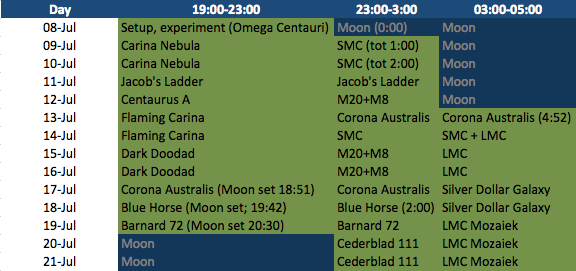A while ago I wrote about picking a destination for an astrophotography holiday and that I will be going to Kiripotib in July (2015). Because availability of rental gear and spots are really limited (8 platforms available), I booked almost a year in advance. That’s a really long wait! But fortunately a lot of planning and preparation is going into a trip like this, so it is actually quite fun to have this long to prepare!
Planning the object list and composition
One of the great things of going to Namibia for astrophotography is the southern sky and to have the center of the Milky Way right above your head! This poses a challenge for planning however, since I don’t know the southern sky well at all. For inspiration I mainly visited websites of other astrophotographers who went to Namibia, or are located somewhere underneath southern skies. When planning you need to know the setup you are planning for of course since you need to think about the field of view and compositions you will acquire with your setup.
I had booked the APM Triplet 107/700 with the Riccardi reducer immediately, so I knew the scope I would be using. However at the time I didn’t know for sure yet which additional DSLR I would bring aside the Nikon D7000 I already owned. But rough planning could begin for the APM + D7000 combo. Objects like LMC, SMC, Carina Nebula, Rho Ophiuchi region seem no-brainers. These fantastic showpieces of the southern sky might be a bit cliche, but they are still worth imaging in my opinion.
Wide fields of the southern sky
Browsing all the photo’s of the southern sky, I realised more and more that there are so many wonderful wide field opportunities! Often a bigger field of view on the same object would show a very nice composition together with another object. So I soon decided to go for a duo setup and use my Nikkor 80-200mm F2.8 at 80 to 105mm next to the APM.
Looking for dust
Another thing I noticed is that there are so many dark nebulas and ‘dusty areas’ that would be excellent for this location. After all, this is a place that’s basically as dark as it gets. So besides the Coal Sack and Corona Australis, I also started to look into the ‘Dark Doodad’ and ‘Jacob’s Ladder’ (not sure if it is commonly named that actually).

Other objects
Of course I also want to have a go at the globular clusters Omega Centauri, 47 Tuc and the Pavo cluster. Furthermore there is 1 galaxy on my list; the ‘Silver Coin Galaxy’ or Sculptor galaxy.
The actual planning
So once I created the list of objects, I wanted to optimise my planning as much as possible so that I would be able to image the objects at the ideal time; when they’re high(est) in the sky. Of course I also need to take the moon into account, as I don’t do any narrow band imaging.
So after a lot of checking in Stellarium for the positioning of the objects at all the times, I had listed the ideal times for the objects. After doing so I thought I might as well make a detailed planning so I would be sure if it was feasible as well as to make sure I don’t waste any time on location deciding what object to image next.
So here is my current planning for the trip:
As you can see I segmented the dark period in 3 parts and assigned at least 2 parts to each object. Both for a decent amount of exposure time but also as a fall back if one night would turn out to be clouded out or anything else goes wrong. For almost every object I will use the Nikon D600 on the APM and my D5100 with the Nikkor 80-200mm F2.8 side by side on the Fornax 51.
Timelapses
Besides the two Nikon’s I’ll be using on the Fornax 51 mount, I’ll be using my Nikon D7000 for the ‘really widefield’ shots and timelapses.
Over the months I already had decided I wanted to do a duo setup, and after investigating different 2nd hand camera’s I noticed I could get the Nikon D5100 relatively cheap while this camera has the same chip as the D7000. Because I also bought the D600 as step-up from my D7000, this meant the D7000 would be available for the more ‘scenery’ shots and timelapses. Since my Sigma 10-20mm was not the best astrophotography lens and also broke a while ago, I decided to get the Samyang 14mm F2.8. This works very well and gets me a nice field of view for timelapses and scenic photo’s.
When investigating all kinds of timelapses I knew I wanted add movement to them since this makes a huge difference in the way the resulting video looks. There are several products that started out as Kickstarter projects and after investigating a lot of them I decided to go for the Cinetics Axis 360 Pro. This product is the cheapest solution at the moment if you want movement on all 3 axis and was available from regular camera stores in the Netherlands.
More
With a long wait like this I seem to keep changing and altering little things in the planning and even doubting the setup; “should I contact them to see if the 8″RC is still available for a few nights?”, “should I get a 300mm lens and bring it instead of using 80mm?”, “Should I look into mounting the Nikon D7000 on the Fornax as well, so I have 3 different angles?” etc. etc.
For now I managed to sticking to the above plan, but I’m sure when I’m actually in Namibia under the stars I’ll be changing some of it 😉
Of course I’m interested to hear from you; did I forget about a beautiful object? other tips?

